Carillon
A carillon (US: /ˈkærəlɒn/ or UK: /kəˈrɪljən/;[1] French: [kaʁijɔ̃]) is a musical instrument that is typically housed in the bell tower (belfry) of a church or municipal building. The instrument consists of at least 23 cast bronze, cup-shaped bells, which are played serially to produce a melody, or sounded together to play a chord. A traditional manual carillon is played by striking a keyboard – the stick-like keys of which are called batons – with the fists, and by pressing the keys of a pedal keyboard with the feet. The keys mechanically activate levers and wires that connect to metal clappers that strike the inside of the bells, allowing the performer on the bells, or carillonneur/carillonist, to vary the intensity of the note according to the force applied to the key.
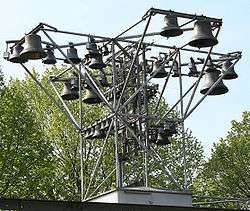 The former carillon in Munich's Olympiapark | |
| Percussion instrument | |
|---|---|
| Classification | Percussion |
| Hornbostel–Sachs classification | 111.242.2 (Sets of bells or chimes) |

Although unusual, real carillons have occasionally been fitted to theatre organs (instead of the metal bars or chimes more often used in simulation), such as the Christie organ installed at the Regal Cinema, Marble Arch, in London.[2] A carillon-like instrument with fewer than 23 bells is called a chime.
The largest carillon in the world with 120 bells, is located in the Palace of Mafra in Portugal.[3][4]
The carillon is the second heaviest of all extant musical instruments,[5] only ranking behind the largest pipe organs. The heaviest carillon in the world (at Riverside Church in New York City) weighs over 100 short tons (91 tonnes),[6] whereas the Wanamaker Organ in Philadelphia weighs 287 short tons (260 tonnes).
The word "carillon" is said to originate from the French quadrillon, meaning four bells. In German, a carillon is also called a Glockenspiel; while the percussion instrument called a "glockenspiel" by English speakers is often called a carillon in French.
History
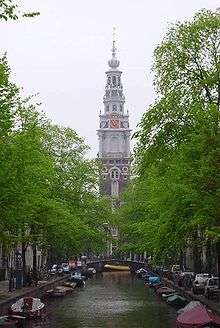
In medieval times, swinging bells were first used as a way of notifying people of imminent church services, and for such as fires, storms, wars and other secular events.
However, the use of bells to play melodic musical compositions originated in the 16th century in the Low Countries. The first carillon was in Flanders, where a "fool" performed music on the bells of Oudenaarde Town Hall in 1510 by using a baton keyboard.
Major figures in the evolution of the modern carillon were Pieter and François Hemony working in the 17th century. They are credited as being the greatest carillon bell founders in the history of the Low Countries. They developed the carillon, in collaboration with Jacob van Eyck, into a full-fledged musical instrument by casting the first tuned carillon in 1644, which was installed in Zutphen's Wijnhuistoren tower.
Musical characteristics
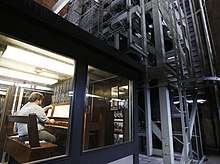
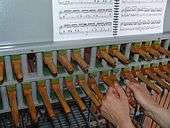
The World Carillon Federation defines a carillon as "a musical instrument composed of tuned bronze bells which are played from a baton keyboard. Only those carillons having at least 23 bells will be taken into consideration. Instruments built before 1940 and composed of between 15 and 22 bells may be designated as 'historical carillons.'"
The Guild of Carillonneurs in North America GCNA defines a carillon as "a musical instrument consisting of at least two octaves of carillon bells arranged in chromatic series and played from a keyboard permitting control of expression through variation of touch. A carillon bell is a cast bronze cup-shaped bell whose partial tones are in such harmonious relationship to each other as to permit many such bells to be sounded together in varied chords with harmonious and concordant effect." The GCNA defines a "traditional carillon" as one played from a carillon mechanical (not electrified) baton keyboard,[7] and a "non-traditional carillon" as a musical instrument with bells, but played by automated mechanical or electro-mechanical means, or from an electrical or electronic keyboard.[8]
Since each note is produced by an individual bell, a carillon's musical range is determined by the number of bells it has. Different names are assigned to instruments based on the number of bells they comprise:
- Carillons with between 23 and 27 bells are referred to as two-octave carillons. Players of these instruments often use music arranged specifically for their limited range of notes.
- A concert carillon has a range of at least four octaves (47 bells). This is sometimes referred to as the "standard-sized" carillon.
The Riverside Carillon in New York City has the largest tuned carillon bell in the world, which sounds C2 (two octaves below middle C).
Travelling or mobile carillons are not placed in a tower, but can be transported. Some of them can even be played indoors—in a concert hall or church—like the mobile carillon of Frank Steijns.[9]
Poorly tuned bells often give an "out of tune" impression and also can be out of tune with themselves. This is due to the unusual harmonic characteristics of foundry bells, which have strong overtones above and below the fundamental frequency.[10]
There is no standard pitch range for the carillon. In general, a concert carillon will have a minimum of 48 bells. The range of any given instrument usually depends on funds available for the fabrication and installation of the instrument: more money allows more bells to be cast, especially the larger, more costly ones. Older carillons can be transposing instruments, generally transposing upward. Most modern instruments sound at concert pitch. A carillon clavier has both a manual and a pedal keyboard.
Carillon music
Carillon music is typically written on two staves. Notes written in the bass clef are generally played by the feet. Notes written in the treble clef are played with the hands. Pedals range from the lowest note (the bourdon) and may continue up to two and half octaves. In the North American Standard keyboard, all notes can be played on the manual.
Because of the acoustic peculiarities of a carillon bell (the prominence of the minor third, and the lack of damping of sound), music written for other instruments needs to be arranged specifically for the carillon.
The combination of carillon and other instruments, while possible, is generally not a happy marriage. The carillon is generally far too loud to perform with most other concert instruments. The great exceptions to this are some late twentieth- and early twenty-first century compositions involving electronic media and carillon. In these compositions, sound amplification is able to match the extreme dynamic range of the carillon and, in the case of sensitive composers, even the most delicate effects are possible. Brass music is often heard together with a (traveling) carillon.
Carillonneurs
The carillonneur or carillonist is the title of the musician who plays the carillon. The carillonneur usually sits in a cabin beneath the bells and plays with the fifth (little) finger pressed down with a loosely closed fist, on a series of baton-like keys arranged in the same pattern as a piano keyboard. The batons are almost never played with the fingers as one does a piano, though this is sometimes used as a special carillon playing technique. The keys activate levers and wires that connect directly to the bells' clappers; thus, as with a piano, the carillonneur can vary the intensity of the note according to the force applied to the key. In addition to the manual keys, the heavier bells are also played with a pedal keyboard. These notes can either be played with the hands or the feet.
Carillon schools
The world's first international carillon school, the Royal Carillon School "Jef Denyn", is in Mechelen, Belgium, where the study of campanology originated. Students from all over the world come to study campanology here. Other carillon schools include the Netherlands Carillon School[11] in Amersfoort, Netherlands.
In North America, one can study the carillon at the University of California, Berkeley, the University of California, Santa Barbara, the University of Michigan in Ann Arbor (which is home to two of only twenty-three grand carillons in the world), the University of Florida, the University of Denver's Lamont School of Music, and Missouri State University, all of which offer complete courses of study. One can also take private lessons at many carillon locations, and there are universities that offer limited credit for carillon performance, such as Clemson University, the University of Kansas, Iowa State University, Grand Valley State University, Marquette University and the University of Rochester.
The George Cadbury Carillon School was opened in 2006 and is the only carillon school in the United Kingdom.[12]
Another international carillon school, the Scandinavian Carillon School[13] in Løgumkloster, Denmark, was established in 1979. It serves mainly Scandinavians, but cooperates with other carillon schools at the university level with student exchange.
A number of universities and undergraduate institutions make use of carillons as part of their tradition. Princeton University houses a carillon of 67 bells which can be heard every Sunday afternoon with performances from Lisa Lonie.[14][15] Yale University in New Haven, Connecticut is home to one of the world's only completely student-led guild of carillonneurs. Members of this group are selected by audition, following an intensive five-week training program for potential recruits. The Yale Memorial Carillon can be heard from the university's iconic Harkness Tower twice a day.[16] A similar student-run program is that of the University of Texas at Austin. Smith College in Northampton, Massachusetts, completed its carillon of 48 bells in 2009, ninety years after the first bells were hung in 1919.[17] Middlebury College in Vermont has a 48-bell carillon located in the steeple of the college's Mead Memorial Chapel.[18] The University of Toronto in Toronto, Canada, has a 51 bell carillon[19] located at Soldiers' Tower, and is the only Canadian university with a functioning carillon.[20]
Composers for carillon
- Johan Adriaenssen
- Emilien Allard
- Samuel Barber
- Ronald Barnes
- John Cage
- John Courter
- George Crumb
- Jef Denyn
- Emma Lou Diemer
- Margriet Ehlen
- Edward Elgar
- Richard Felciano
- Wim Franken
- Frans Geysen
- Matthias van den Gheyn
- Bengt Hambraeus
- Hans Kockelmans
- Giedrius Kuprevičius
- Libby Larsen
- Lowell Liebermann
- Arne Nordheim
- Charlemagne Palestine
- Vincent Persichetti
- Olesya Rostovskaya
- David Sargent
- Augusta Read Thomas
- Roman Turovsky-Savchuk
- Merlijn Twaalfhoven[21][22]
- Mary Jeanne van Appledorn
- Charles Wuorinen
Notable carillonneurs
- Georges-Jacques Aelsters (1770–1849) – Belgium
- Ronald Barnes (1927–1997) – United States
- Maria Blom – Belgium
- Adèle Colson (1905-1997) – Belgium
- Ruth Muzzy Conniston (1892-1952) – United States
- Mary Mesquita Dahlmer (1897–1993) – United States
- Jef Denyn (1862–1941) – Belgium
- Jacob van Eyck (1590–1657) – Netherlands
- Lyn Fuller – Australia
- Wim Franken (1922–2012) – Netherlands
- Hans Uwe Hielscher (born 1945) – Germany
- Monika Kaźmierczak, Poland
- Ulla Laage (born 1949) – Denmark
- Nora Johnston (1886–1952) – England
- Olesya Rostovskaya – Russia
- Gordon Slater – Canada
- Sally Slade Warner (1932-2009) – United States
- Gladys Watkins (1884–1939) – New Zealand
- Wendell Westcott (1911–2010) – Michigan State University, United States
- Julianne Vanden Wyngaard – United States
Mechanical gallery
 Salzburg carillon control drum. There are 7940 holes where screws can be inserted.
Salzburg carillon control drum. There are 7940 holes where screws can be inserted. Machinery for playing automated music on a carillon, inside the Belfry, Ghent, Belgium
Machinery for playing automated music on a carillon, inside the Belfry, Ghent, Belgium A modern carillon keyboard with much of the mechanism enclosed.
A modern carillon keyboard with much of the mechanism enclosed. Carillonneur Brian Swager plays the historic carillon of Amédée Bollée at the Perpignan Cathedral.
Carillonneur Brian Swager plays the historic carillon of Amédée Bollée at the Perpignan Cathedral.
Instruments by country
Number of traditional carillons by country, with each country linked to its country-specific list of carillons:
| Country | Number of carillons |
|---|---|
| Netherlands | 197[23] |
| United States | 166[24] |
| Belgium | 89 |
| Germany | 45 |
| France | 27 |
| Denmark | 23 |
| United Kingdom | 19 |
| Norway | 12 |
| Canada | 11[20] |
| Czech Republic | 6 |
| Australia | 4[25] |
| Lithuania | 4 |
| Poland | 3 |
| Russia | 2 |
| Israel | 1 |
| Republic of Ireland | 1 |
| Serbia | 1 |
Media
Gallery of notable carillons


 The Peace Tower, completed in 1922 and sitting on the Centre Block of the Canadian Parliament Buildings in Ottawa, Ontario, contains a 53-bell carillon.
The Peace Tower, completed in 1922 and sitting on the Centre Block of the Canadian Parliament Buildings in Ottawa, Ontario, contains a 53-bell carillon. The Exhibition Place Carillon, built in 1974 and located in Toronto, Ontario, Canada at The Exhibition Place, contains 50 bells.
The Exhibition Place Carillon, built in 1974 and located in Toronto, Ontario, Canada at The Exhibition Place, contains 50 bells. The Netherlands Centennial Carillon is a 90-foot bell tower located in Victoria, British Columbia. It contains a 62-bell carillon.
The Netherlands Centennial Carillon is a 90-foot bell tower located in Victoria, British Columbia. It contains a 62-bell carillon. The Soldiers' Tower, a memorial to alumni fallen in the World Wars, contains a 51-bell carillon (University of Toronto).
The Soldiers' Tower, a memorial to alumni fallen in the World Wars, contains a 51-bell carillon (University of Toronto). The World War I Memorial Carillon, a 56-bell carillon located in Byrd Park in Richmond, Virginia
The World War I Memorial Carillon, a 56-bell carillon located in Byrd Park in Richmond, Virginia Netherlands Carillon, Arlington, Virginia, US
Netherlands Carillon, Arlington, Virginia, US.jpg) Century Tower (University of Florida)
Century Tower (University of Florida) Burton Memorial Tower, University of Michigan
Burton Memorial Tower, University of Michigan Lurie Tower, North Campus, University of Michigan
Lurie Tower, North Campus, University of Michigan The 104-foot Beaumont Tower of Michigan State University, with a 49-bell carillon
The 104-foot Beaumont Tower of Michigan State University, with a 49-bell carillon Storke Tower, the 175-foot University of California, Santa Barbara bell tower with a 61-bell carillon
Storke Tower, the 175-foot University of California, Santa Barbara bell tower with a 61-bell carillon The 161-foot University of California, Riverside bell tower with a 48-bell carillon
The 161-foot University of California, Riverside bell tower with a 48-bell carillon Campanile and 50-bell Stanton Memorial Carillon, Iowa State University, Ames
Campanile and 50-bell Stanton Memorial Carillon, Iowa State University, Ames- University of Northern Iowa Campanile and 47-bell carillon, built in 1926, Cedar Falls
 Jane A. Meyer Carillon, Missouri State University, Springfield
Jane A. Meyer Carillon, Missouri State University, Springfield The Plummer Building, Mayo Clinic, Rochester, Minnesota, houses the 56-bell Rochester Carillon, with bells installed in 1928 and 1977.
The Plummer Building, Mayo Clinic, Rochester, Minnesota, houses the 56-bell Rochester Carillon, with bells installed in 1928 and 1977.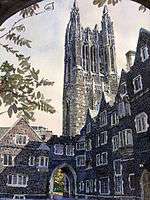 Class of 1892 Bells, Princeton University Graduate College, with a 67-bell carillon
Class of 1892 Bells, Princeton University Graduate College, with a 67-bell carillon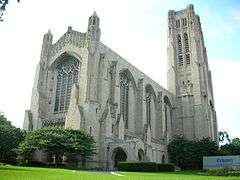 Rockefeller Memorial Chapel, the University of Chicago, with the 72-bell Laura Spelman Rockefeller Memorial Carillon
Rockefeller Memorial Chapel, the University of Chicago, with the 72-bell Laura Spelman Rockefeller Memorial Carillon Duke University Chapel's 50-bell carillon, played weekdays at 5:00 p.m. and before and after Sunday worship services and special events.[26]
Duke University Chapel's 50-bell carillon, played weekdays at 5:00 p.m. and before and after Sunday worship services and special events.[26]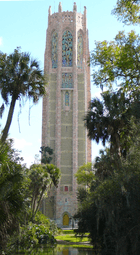 The Bok Singing Tower, a 60-bell carillon cast by Taylor, houses the Anton Brees Carillon Library and the archives of the Guild of Carillonneurs in North America (GCNA).
The Bok Singing Tower, a 60-bell carillon cast by Taylor, houses the Anton Brees Carillon Library and the archives of the Guild of Carillonneurs in North America (GCNA).
 National War Memorial, New Zealand: a 74-bell carillon, including the largest carillon bell in the southern hemisphere ("Peace", 12.5 ton)
National War Memorial, New Zealand: a 74-bell carillon, including the largest carillon bell in the southern hemisphere ("Peace", 12.5 ton) Mobile carillon, Poland
Mobile carillon, Poland University of Kansas Campanile, Lawrence
University of Kansas Campanile, Lawrence The Wisbech Institute Clock Tower, 23-bell carillon, Wisbech, Cambridgeshire, UK
The Wisbech Institute Clock Tower, 23-bell carillon, Wisbech, Cambridgeshire, UK Loughborough, UK, the WW1 memorial carillon in Queen's Park.
Loughborough, UK, the WW1 memorial carillon in Queen's Park.
- The Torre Insignia carillon in Mexico City. 47 bronze bells, weighs 26 tons.[29] At 125 m, it is the world's tallest carillon tower, which is part of the old headquarters of the Banco Nacional de Obras y Servicios Publicos in the Tlatelolco neighbourhood.
See also
- Chime (bell instrument)
- Kirk in the Hills, world's largest carillon, 77 bells
- List of carillons
- Mission Inn: Carrie Jacobs-Bond, "A Perfect Day"
References
- "carillon noun - Definition, pictures, pronunciation and usage notes | Oxford Advanced Learner's Dictionary at OxfordLearnersDictionaries.com". Oxfordlearnersdictionaries.com.
- "Picture Gallery – Regal, Marble Arch (15)". Organrecitals.com. Retrieved 27 October 2015.
- http://robsonranchviews.com/word-of-the-month-carillon/
- https://www.europanostra.org/european-experts-put-forward-action-plan-restore-carillons-mafra-palace-portugal/
- "Sunday Carillon Concerts at Peter and Paul Fortress". Inyourpocket.com. Retrieved 2019-01-24.
- "The Riverside Church: The Carillon". New York, NY: The Riverside Church in the City of New York. Archived from the original on 2016-06-30. Retrieved 22 January 2018.
- "Archived copy". Archived from the original on 2013-09-28. Retrieved 2013-09-24.CS1 maint: archived copy as title (link)
- "Archived copy". Archived from the original on 2013-09-28. Retrieved 2013-09-24.CS1 maint: archived copy as title (link)
- Frank Steijns.
- "The Sound of Bells – Overview of tuning". Hibberts.co.uk.
- "Utrecht School of the Arts, Faculty of Music". Archived from the original on 2012-10-18.
- "Carillon Summer series". Indiana State University. 2008. Archived from the original on 2010-05-04. Retrieved 2009-12-02.
- "KMS". Locus Dei. Archived from the original on 2007-07-31.
- "About the Carillon". Princeton University. Retrieved 1 February 2019.
- "Meet the Carillonneur". Princeton University. Retrieved 1 February 2019.
- "Yale Guild of Carillonneurs". Yale University.
- "Long-awaited Bell to Complete Smith College Carillon" (Press release). Smith College. 16 March 2009.
- "The Middlebury College Carillon". Middlebury College. Archived from the original on 2011-12-14. Retrieved 2012-03-26.
- "The Soldier's Tower". University of Toronto.
- "Carillon". Encyclopedia of Music in Canada. Historica Canada.
- "Home – De Zingende Toren". Dezingendetoren.nl.
- "SA283 Grade C Steel,SA283 Grade C Plate,SA283 Grade C Coil Supplier – SA283 Grade C Steel Supplier". Cultuurcampusvleuterweide.nl.
- Lijst van beiaarden in Nederland
- "FAQ : Hopeman Memorial Carillon : University of Rochester". Sas.rochester.edu.
- "The Carillon City Bells Toll for Perth!". Carillon City. 23 May 2013. Archived from the original on 20 June 2013. Retrieved 11 August 2019.
- "Carillon", Chapel, US: Duke.
- "ROUEN : restauration du Carillon de la Cathédrale Notre-Dame". Paccard.com.
- "Restaurées à Annecy, les cloches de la cathédrale seront de retour à Rouen, après Pâques".
- Tlatelolco, Vivir En (2012-03-26). "Vivir en Tlatelolco: El carrillón de Tlatelolco". Vivir en Tlatelolco. Retrieved 2019-05-06.
Further reading
- Boogert, Loek, André Lehr, and Jacques Maassen. 45 Years of Dutch Carillons, 1945–1990. Asten, the Netherlands: Netherlands Carillon Society, 1992. ISBN 90-900345-0-1.
- Huybens, Gilbert. Carillons et Tours de Belgique. Ghent, Belgium: Ludion Editions, 1994. ISBN 90-5544-019-1.
- Keldermans, Karel, and Linda Keldermans. Carillon: The Evolution of a Concert Instrument in North America. Springfield, IL: Springfield Park District, 1996. ISBN 0-9652252-0-8.
- Lehr, André. The Art of the Carillon in the Low Countries. Tielt, Belgium: Lannoo, 1991. ISBN 90-209-1917-2.
- Rombouts, Luc. Singing Bronze: A History of Carillon Music. Leuven, Belgium: Leuven University Press, 2014. ISBN 978-90-5867-9567.
- Swager, Brian. A history of the carillon: its origins, development, and evolution as a musical instrument. Document (D. Mus.). Indiana University, 1993.
- Willis, Stephen Charles. Bells through the Ages: from the Percival Price Collection = Les Cloches à travers les siècles: provenant du fonds Percival Price. Ottawa: National Library of Canada, 1986. 34 p., ill. with b&w photos. N.B.: Prepared on the occasion of an exhibition of the same title, based on the collection of bell and carillon related material and documentation, of former Dominion Carilloneur (of Canadian Parliament, Ottawa), Percival Price, held at the National Library of Canada (as then named), 12 May to 14 Sept. 1986; some copies come with the guide to the taped dubbings of the recordings played as background music to the displays, as technically prepared by Gilles Saint-Laurent and listed by Stephen Charles Willis, both of the library's Music Division; English and French texts respectively divided into upper and lower portions of each page. ISBN 0-662-54295-9
External links
| Wikimedia Commons has media related to Carillons. |
| Wikisource has the text of the 1911 Encyclopædia Britannica article Carillon. |
- World Carillon Federation (including information on the WCF 2006 carillon keyboard standard)
- British Carillon Society
- Guild of Carillonneurs in North America
- Tower Bells Worldwide lists and technical details for carillons (traditional and non-traditional), chimes, etc.
- Flemish Carillon Guild
- Royal Carillon School "Jef Denyn", Mechelen, Belgium
- Museum Klok en Peel (Carillon Museum in the Netherlands)
- Yale University Guild of Carillonneurs
- University of Kansas World War II Memorial Campanile and Carillon
- Peace Tower Carillon, Ottawa, Ontario, Canada
- The Carillon. A history of the carillon with particular attention to the carillon and carillon music in the times of Johannes Vermeer.
- Images of the Carillon Tower Niagara Falls from the Niagara Historic Digital Collections
- Mobile/traveling Carillon of Frank Steijns
- Cast in Bronze traveling carillon
- Utrechtse Klokkenspel Vereniging (Utrecht Carillon Society)
- Netherlands Carillon School
- Dutch Carillon Society, the Netherlands
- John Klein: "A Christmas Sound Spectacular" (RCA, 1959) full album on YouTube – electronic carillon recording
- John Klein: "Let's Ring The Bells All Around The Christmas Tree" (RCA, 1964) full album on YouTube – electronic carillon recording
- Rose Marie Seuntiens, NL, archived from the original on 2011-07-24
- Joey Brink: "Composing for Carillon" Onsite explanation and demonstration at University of Chicago with linked article at: Brink, Joey (19 December 2017). "Composing for Carillon". NewMusicBox. Retrieved 21 September 2019.
